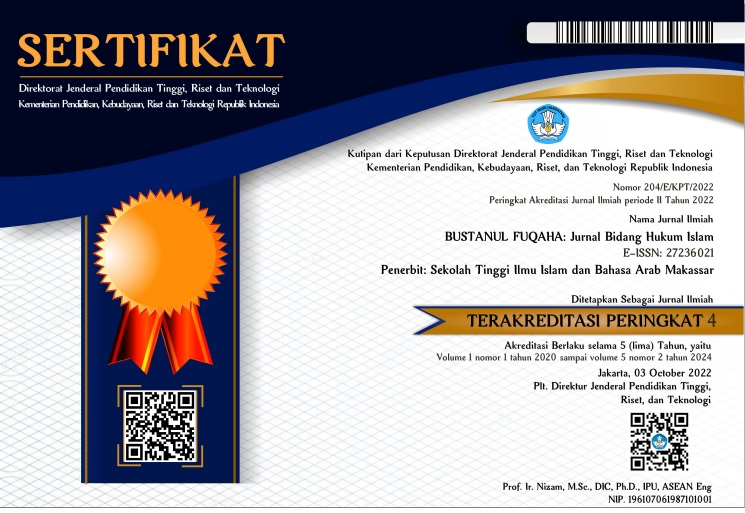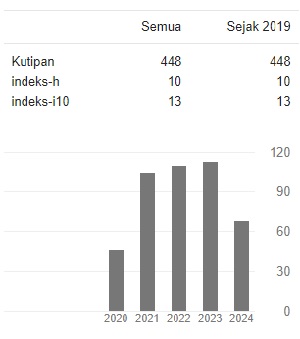Arah Kiblat dalam Salat: Menyikapi Perbedaan Antara Mazhab Hanafi dan Syafi’i
Qibla Direction in Prayer: Responding to the Differences Between Hanafi and Shafi’i School
DOI:
https://doi.org/10.36701/bustanul.v2i3.404Keywords:
Qibla Direction, 'Ain al-Ka'bah, Jihat al-Ka'bahAbstract
The purpose of this study is to find out the solutions that can be taken by Muslims regarding the differences of opinion between the Hanafi School and the Syafii School about the direction of Qibla which more or less has an impact on Muslims, especially in Indonesia. In this study, to get answers to the problems above, the author uses analytical descriptive research or istinbāṭ al-aḥkām which focuses on the study of manuscripts and texts, using historical approaches, and normative juridical. The results of this study indicate that: Muslims who will carry out the construction of mosques need to adjust the position of the Kaaba appropriately by maximizing existing technology, so that there are no disputes in the future. However, if the mosque has been built, and then it is alleged that it deviated slightly from 'ain al-ka'bah, then there is no need to cancel the ijtihad with a new ijtihad by tilting the rows, because the prayers that are performed towards the Ka'bah are still valid, even though they are not in the right direction. ain al-ka'bah, while tearing down the mosque or tilting the saf, will only create new problems and be very burdensome for the people. For people who pray alone, it is highly recommended to face the Qiblah by aiming correctly at 'ain al-ka'bah as much as possible without making it difficult for themselves.
Downloads
References
RI, Kementrian Agama. Al-Qur’an Dan Terjemahnya. Jakarta Timur: Ummul Qura, 2018.
Abu Habīb, Sa’dī. Al-Fiqh Al-Manhajī Fī Mazhab Al-Imām Al-Syāfi’ī. Cet. II. Damaskus: Dār al-Fikr, 1988.
———. Al-Qamūs Al-Fiqh Lugah Wa Iṣṭilāh. Cet. II. Damaskus: Dār al-Fikr, 1988.
Al-Aṣfahānī, Aḥmad ibn al-Husain. Matan Gāyah Al - Tagrīb. Cet. II. Dār al-Hijrah, 2016.
Al-Bukhārī, Muḥammad ibn Ismā’īl ibn Ibrāhīm. Ṣahīh Al-Bukhārī. Cet. I. al-Qāhirah: Dār ibn al-Jauzī, 2010.
Al-Ḥanafī, Aḥmad ibn Mūsā. Al-Bināyah Syarḥ Al-Hidāyah. Cet. I. Bairūt: Dār al-Kutub al-‘Alamiyyah, 2000.
al-Ḥanafī, Ayyūb ibn Mūsā. “Al-Kalimāt Mu’jam Fī Al-Muṣṭalaḥāt Wa Al-Furūq Al-Lugawiyyah.” Beirūt: Muassasah al-Risālah, n.d.
al-Ḥanafī, Muḥammad ibn Abī Bakar. “Tuḥfah Al-Mamlūk,” Cet. I. Beirūt: Dār al-Basyāir al-Islāmiyyah, n.d.
al-Ḥanbalī, ‘Abd al-Raḥmān ibn Aḥmad ibn Rajab. “Fatḥ Al-Bārī Syarḥ Ṣaḥīḥ Al-Bukhārī,” Cet. I. al-Madinah al-Nabawiyyah: Maktabagh al-Gurabā’ al-Aṡariyyah, 1996.
al-Kasānī, Abu Bakar ibn Mas’ūd. “Badāi’ Al-Ṣanāi’ Fi Tartīb Al- Syarāi’.” Dār al-‘Alamiyyah, 1986.
al-Māwardī, ‘Alī ibn Muḥammad. “Al-Ḥāwī Al-Kabīr Fī Al-Fiqh Mazhab Al-Imām Al-Syāfi’ī,” 1999.
Al-Mubārakfūrī, Ṣafy al-Raḥmān. “Raḥīq Al-Makhtūm,” Cet. I. Beirūt: Dār al-Halāl, n.d.
Al-Mursī, ‘Alī ibn Ismā’īl. “Al-Muḥkam Al-Muḥīṭ Al- A’ẓam,” Cet.I. Dār al-Kutub al-‘Alamiyyah, 2000.
al-Nawawī, Yahyā ibn Syaraf. “Al-Majmū’ Syarh Al-Muhażżab.” Dār al-Fikr, n.d.
al-Qalyūbī, Aḥmad Salāmah dkk. “Ḥāsyiyā Qalyūbī Wa ‘Umairah.” Beirūt: Dār al-Fikr, 1995.
al-Qurtubī, Ibn Rusyd. “Bidāyah Al-Mujtahid Wa Nihāyah Al-Muqtaṣid,” Cet. I. al-Qāhirah: Dār al-Salām, 2016.
al-Rūmī, Muḥammad ibn Muḥammad. “Al-‘Ināyah Syarh Al-Hidāyah.” Dār al-Fikr, n.d.
Al-Ṣābūnī, Muḥammad ‘Alī. “Rawāi’ Al-Bayān Tafsīr Āyāt Al-Aḥkām,” Cet. II. Damaskus: Maktabah al-Gazālī, 1980.
al-Sarkhasī, Muḥammad ibn Aḥmad. “Al-Mabsūṭ.” Bairūt: Dār al-Ma’rifah, 1993.
al-Syāfi’ī, Muḥammad ibn Idrīs. “Al-Umm.” Beirūt: Dār al-Ma’rifah, 1990.
Al-Tirmidżī, Muḥammad ibn ‘Īsā. “Sunan Al-Tirmiżī,” Cet. II. Mesir: Syarikah Maktabah wa Maṭba’ah Musṭafā al-Bābī al-Ḥalabī, 1973.
Budiwati, Anisah. “Akurasi Arah Kiblat Masjid Di Ruang Publik.” JSSH (Jurnal Sains Sosial Dan Humaniora) 2, no. 1 (2018): 159. doi:10.30595/jssh.v2i1.2275.
Butar-Butar, Arwin Juli Rakhmadi. Kakbah Dan Problematika Arah Kiblat. Yogyakarta: Museum Astronomi Islam, 2013.
Haris, Rizki Muhammad. “HUKUM SALAT YANG TIDAK SESUAI ARAH KIBLAT: Studi Kasus Masjid-Masjid Di Kecamatan Sidamanik.” AT-TAFAHUM: Journal of Islamic Law 1, no. 1 (2017): 137.
“Https://Bimasislam.Kemenag.Go.Id/Post/Berita/Ini-Waktu-Tepat-Cek-Arah-Kiblat (30,” n.d.
Ibn Mājah, Muḥammad ibn Yazīd. “Sunan Ibn Mājah.” Dār Iḥya’ al-Kutub al-‘Arabiyyah, n.d.
Majelis Ulama Indonesia. Majelis Ulama Indonesia, Himpunan Fatwa Majelis Ulama Indonesia Sejak 1975. Erlangga, n.d.
Muḥammad, Abd al-Raḥmān. Bugyah Al-Mustsyrisdiīn. Beirūt: Dār al-Fikr, 1994.
Munif, Ahmad. “Analisis Kontroversi Dalam Penetapan Arah Kiblat Masjid Agung Demak.” IAIN Walisongo, 2013.
RI, Kementerian Agama. Alquran Dan Terjemahannya.Pdf, n.d.
RI, Kementrian Agama. Al-Qur’an Dan Terjemahnya. Jakarta Timur: Ummul Qura, 2018.
Sālim, Kamāl ibn al-Sayyid. “Ṣaḥīḥ Fiqh Al-Sunnah Wa Adillatuh Wa Tauḍīḥ Mażāhib Al-Aimmah.” al-Qāhirah: al-Maktabah al-Tauqīfiyyah, 2003.
Usman, Mukran H., Aswar Aswar, and Azwar Iskandar. “Menuju Indonesia Berkemajuan Dalam Studi Peradaban Islam” 21, no. 1 (2021): 39–74. doi:https://doi.org/10.24042/ajsk.v21i1.7862.
Usman, Mukran H., Aswar Aswar, and Zulfiah Sam. “Covid-19 Dalam Perjalanan Akhir Zaman: Sebab, Dampak Dan Anjuran Syariat Dalam Menghadapinya.” BUSTANUL FUQAHA: Jurnal Bidang Hukum Islam 1, no. 2 (2020): 137–55. doi:10.36701/bustanul.v1i2.142.
Usman, Mukran H., Azwar Iskandar, and Aswar Aswar. “Covid-19: Menguji Kebenaran Konspirasi Global.” Jurnal Studi Agama Dan Masyarakat 16, no. 2 (2021): 122–31. doi:10.23971/jsam.v16i2.2238.
Usman, Mukran H, and Aswar Aswar. “Korelasi Kehidupan Berislam Masyarakat Desa Baruga Dengan Kemakmuran, Keamanan Dan Ketentraman Hidup.” Al-Din: Jurnal Dakwah Dan Sosial Keagamaan 6, no. 1 (2020): 1–14. doi:http://dx.doi.org/10.35673/ajdsk.v6i1.845.














